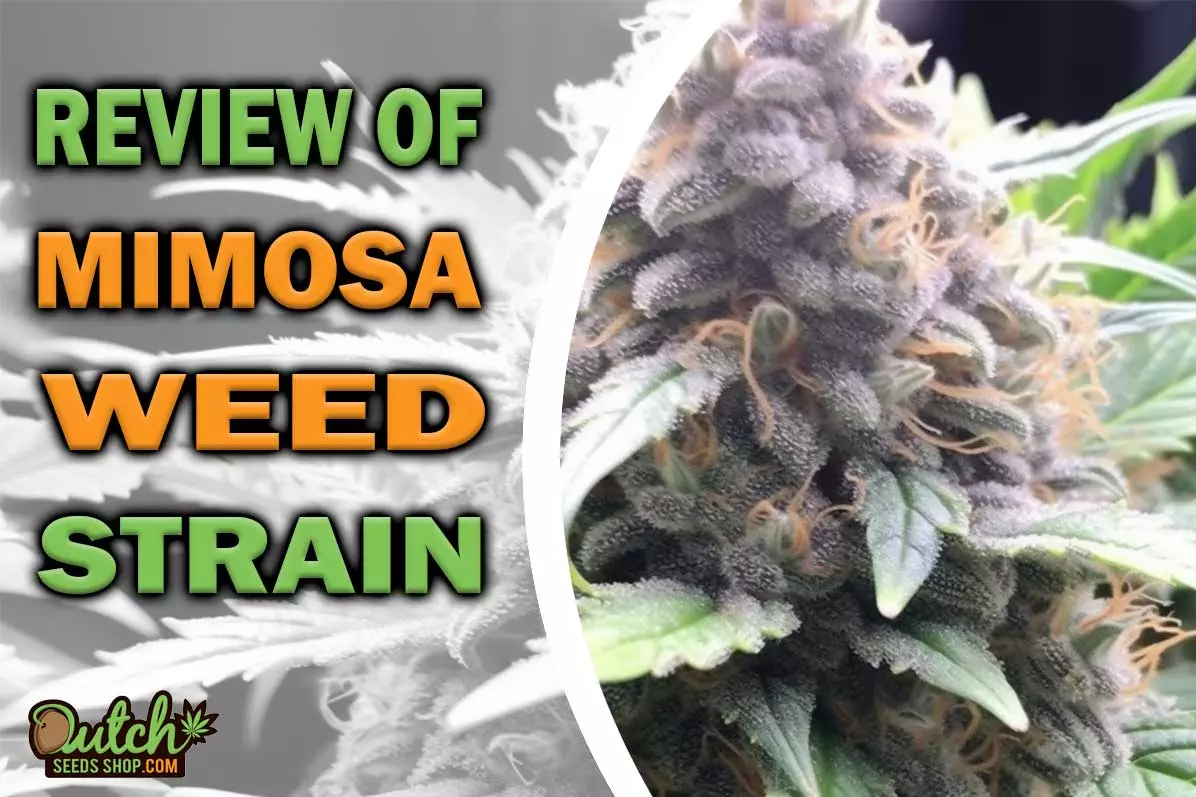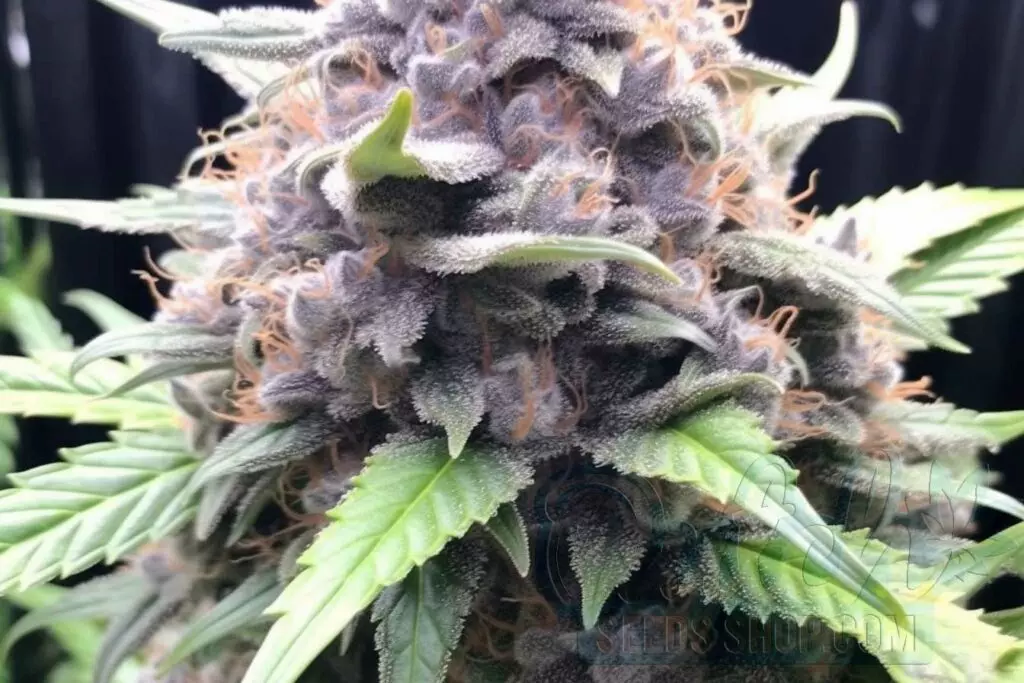Mimosa Marijuana Strain Information and Review
The Mimosa strain, a vibrant and dynamic addition to the cannabis family, has swiftly captured the hearts of enthusiasts and connoisseurs alike. A masterpiece of genetic engineering, Mimosa embodies the evolution of cannabis strains, blending tradition with innovation.

Type: 30% Indica / 70% Sativa
Genetic: Clementine x Purple Punch
THC: 22 – 27%
CBD: 0.01 – 1%
Terpenes: Limonene, Linalool, Phellandrene, Sabinene, Valencene
Flowering Time: 68 – 78 days
Indoor Yield: 1.8 – 2.3 oz/ft²
Outdoor Yield: 30 – 70 oz/plant
Effects: Creative, Energetic, Euphoric, Happy
Flavors/Taste: Citrus, Orange, Sweet, Tropical
Its rising popularity is a testament to its exceptional qualities, including its powerful effects, tantalizing flavors, and versatile benefits.
This comprehensive review delves deep into the essence of Mimosa, exploring its origins, characteristics, and why it stands out in the diverse world of cannabis.
Key Takeaways:
- Mimosa is a Sativa-dominant hybrid, bred from Clementine and Purple Punch, known for its uplifting and energizing effects.
- It features a vibrant appearance with dense buds, a kaleidoscope of colors, and a frosty trichome coating.
- The strain’s high THC content (22-27%) and low CBD (<1%) contribute to its potent psychoactive effects.
- Mimosa’s terpene profile, rich in myrcene, limonene, and caryophyllene, creates a unique citrus and sweet aroma and flavor.
- Medically, Mimosa is effective in relieving stress, anxiety, and depression, enhancing mood without significant sedation.
- Mimosa can be grown both indoors and outdoors, with a moderate growth difficulty and substantial yields.
- The flowering period for Mimosa ranges from 68 to 78 days, yielding 1.8 to 2.3 oz/ft² indoors and 30 to 70 oz per plant outdoors.
- Compared to similar strains, Mimosa stands out for its unique flavor profile, high THC content, and balanced effects.
Mimosa Strain Genetics
Mimosa’s genetic profile is a remarkable feat of breeding, combining the strengths of its parent strains to create something truly unique.
This section explores the meticulous craftsmanship behind Mimosa’s creation, shedding light on the science and artistry of cannabis genetics.
It’s not just a strain; it’s a celebration of genetic diversity and the endless possibilities within the cannabis breeding world.
Origins and Lineage
The origins of the Mimosa strain lie in the deliberate and skillful crossbreeding of Clementine and Purple Punch strain.
This genetic combination brings together the best of both worlds – Clementine’s strain invigorating citrus aroma and Purple Punch’s deeply relaxing effects.
The breeders’ choice of these parent strains showcases a strategic approach to developing a hybrid that balances Sativa’s uplifting qualities with Indica’s soothing influence.
This lineage is a clear reflection of the breeders’ commitment to quality and innovation, resulting in a strain that’s both versatile and delightful.
History
Tracing the history of Mimosa, we uncover a narrative rich with dedication and expertise.
Since its emergence, Mimosa has quickly risen to prominence, a reflection of the evolving preferences and needs of cannabis users.
Its journey from a novel hybrid to a beloved staple in dispensaries underscores its adaptability and appeal.
The development of Mimosa marks a significant milestone in cannabis cultivation, demonstrating how creative breeding techniques can lead to exceptional results.
Appearance of Mimosa Weed
The appearance of the Mimosa plant is a visual feast, showcasing nature’s artistry in cannabis cultivation.
The plant’s striking hues and distinctive bud structure are a testament to its unique genetics.
Colors and Bud Structure:
- Colors: Mimosa’s buds exhibit a kaleidoscope of colors, ranging from deep purples and vibrant greens to the occasional splash of fiery orange, courtesy of its prominent pistils. This vibrant color palette makes Mimosa a visually appealing choice for both growers and users.
- Bud Structure: The buds of Mimosa are known for their density and compactness, covered in a generous coating of crystal-like trichomes. These frosty trichomes not only add to the aesthetic appeal but also indicate the potency and terpene-rich profile of the strain.
Is Mimosa Indica or Sativa?

Mimosa, with its 70% Sativa and 30% Indica genetic makeup, is predominantly a Sativa-dominant hybrid.
This classification is evident in its energizing and uplifting effects, typical of Sativa strains, while the Indica component adds a subtle yet noticeable layer of relaxation.
This blend makes Mimosa a versatile strain, suitable for various settings and purposes, balancing the cerebral buzz of Sativa with the calming essence of Indica.
Cannabinoids and Terpenes
The Mimosa strain is a magnificent example of the intricate balance of cannabinoids and terpenes, contributing to its unique characteristics.
This section delves into the complex chemistry of Mimosa, exploring how these compounds synergistically contribute to the strain’s aroma, flavor, and therapeutic properties.
Understanding these elements is essential for appreciating the full spectrum of Mimosa’s appeal.
Terpenes Profile
The terpene profile of Mimosa plays a pivotal role in defining its distinct aroma and flavor.
These aromatic compounds, each with their unique qualities, combine to create a sensory experience that is both delightful and complex.
- Myrcene: Imparts a subtly sweet and earthy aroma, grounding the scent with a touch of herbal notes.
- Limonene: Adds a burst of citrus, evoking the fresh, tangy essence of oranges and lemons.
- Caryophyllene: Brings a hint of spice, contributing to the strain’s depth and complexity.
THC and CBD levels
The cannabinoid profile of Mimosa is notable for its high THC and low CBD content, shaping its potent effects.
| Cannabinoid | Level (%) |
| THC | 22 – 27 |
| CBD | < 1 |
This high THC content is responsible for Mimosa’s strong psychoactive effects, while the minimal CBD levels focus the experience more on recreational and less on medicinal benefits.
Aroma and Flavor
Mimosa’s aroma and flavor are a true feast for the senses.
Upon first encounter, one is greeted with a strong citrus scent, reminiscent of fresh oranges and lemons, thanks to its limonene content.
This citrusy burst is beautifully complemented by sweeter, tropical undertones, creating a refreshing and invigorating olfactory experience.
The flavor mirrors this aromatic profile, offering a delightful taste that lingers pleasantly on the palate.
Mimosa Strain Effects and Medical Benefits
Mimosa’s effects and medical benefits are as multifaceted as its genetic makeup.
This section explores the range of sensations and therapeutic uses of Mimosa, highlighting how it caters to both recreational enjoyment and medicinal relief.
Feelings

Consuming Mimosa often leads to a dynamic range of feelings.
Users typically report a surge of happiness and energy, making it an excellent choice for daytime use or social settings.
Its Sativa dominance promotes creativity and euphoria, making mundane tasks more enjoyable and stimulating artistic endeavors.
This uplifting effect is balanced with a subtle Indica-induced relaxation, preventing overwhelming jitters or anxiety.
Negatives
Despite its many positives, Mimosa can have some negative side effects, particularly for those sensitive to THC.
Commonly reported issues include dry mouth and dry eyes, which are easily manageable with hydration and eye drops.
Inexperienced users or those with a low tolerance may experience mild anxiety or paranoia, especially at higher doses.
Mimosa Strain Helps With
Medically, Mimosa is known to be particularly effective in alleviating stress, anxiety, and depression.
Its uplifting effects can provide significant relief for those battling mental health issues.
Additionally, its energizing qualities make it a suitable option for combating fatigue and lethargy.
While its low CBD content limits its efficacy for severe pain or inflammation, the overall mood-enhancing and relaxing properties of Mimosa make it a valuable strain in the medical cannabis arsenal.
Growing Mimosa
Growing Mimosa is an endeavor that combines challenge and reward in equal measure.
This section provides comprehensive insights into cultivating this exceptional strain, from obtaining the right seeds to nurturing the plants to full bloom.
Mimosa’s moderate growth difficulty level makes it an intriguing choice for both novice and experienced growers, offering a chance to refine cultivation skills while enjoying substantial yields.
Mimosa Seeds
When selecting Mimosa seeds, growers have the option of regular, feminized, and autoflowering varieties.
Each type offers distinct advantages:
- Regular Seeds: Ideal for breeders, they produce both male and female plants, essential for creating new strains or seeds.
- Feminized Seeds: These seeds are treated to produce only female plants, ensuring that all plants will flower. This is a convenient choice for growers focusing solely on bud production.
- Autoflowering Seeds: These seeds are less dependent on light cycles to flower, making them a robust choice for less controlled environments. They are particularly suitable for beginners or those looking for a more straightforward growing process.
Growing Guide
Cultivating Mimosa requires a blend of careful planning and attentive care.
This guide serves as a roadmap for growing healthy Mimosa plants, covering everything from the initial setup to the final stages of flowering.
Indoor and Outdoor Growing Info
Indoor Growing:
- Controlled Environment: Growing Mimosa indoors allows for precise control over temperature, humidity, and light cycles, leading to potentially higher quality buds.
- Space and Equipment: Indoor cultivation requires adequate space and essential equipment like grow lights, ventilation systems, and humidity controllers.
Outdoor Growing:
- Natural Conditions: Mimosa thrives in a mild climate when grown outdoors, benefiting from natural sunlight and aeration.
- Larger Plants and Yields: Outdoor plants usually grow larger and yield more, but they are more susceptible to pests and weather variations.
Feeding Mimosa Plants
Feeding Mimosa plants correctly is crucial for their growth and bud production.
A balanced nutrient regimen, including nitrogen, phosphorus, and potassium, along with trace elements like magnesium and calcium, is essential.
During the vegetative stage, a higher nitrogen concentration is beneficial, whereas flowering plants require more phosphorus and potassium.
Consistent monitoring and adjusting of pH levels in the soil or growing medium ensure nutrient availability and plant health.
Flowering Time and Yield of Mimosa Seeds

Mimosa’s flowering period typically spans 68 to 78 days.
Growers can expect substantial yields, reflecting the plant’s robust growth potential.
| Growing Environment | Yield |
| Indoor | 1.8 to 2.3 oz/ft² |
| Outdoor | 30 to 70 oz per plant |
Comparison of Alternative Strains to Mimosa Strain
Comparing Mimosa to similar strains offers valuable insights into its unique characteristics.
| Strain | THC Content | CBD Content | Flowering Time | Yield |
| Mimosa | 22 – 27% | < 1% | 68 – 78 days | High |
| Mimosa Champagne | Similar | Similar | Comparable | Comparable |
| Mimosa Cake | Slightly Lower | Similar | Comparable | Comparable |
| Mimosa X Orange Punch | Comparable | Comparable | Similar | Similar |
| Purple Mimosa | Comparable | Similar | Similar | Similar |
| Pineapple Mimosa | Slightly Higher | Similar | Comparable | Comparable |
FAQ
What is the ideal climate for growing Mimosa?
Mimosa thrives best in a mild climate, with controlled humidity and temperature when grown indoors.
Can Mimosa be grown by beginners?
Yes, while Mimosa has a moderate difficulty level, it can be cultivated by beginners with some basic knowledge and careful attention.
What are the primary effects of consuming Mimosa?
Mimosa is known for its uplifting and energizing effects, often inducing feelings of happiness and creativity.
How does Mimosa help medically?
Mimosa is beneficial in alleviating stress, anxiety, and depression, thanks to its mood-enhancing properties.
About the Author
